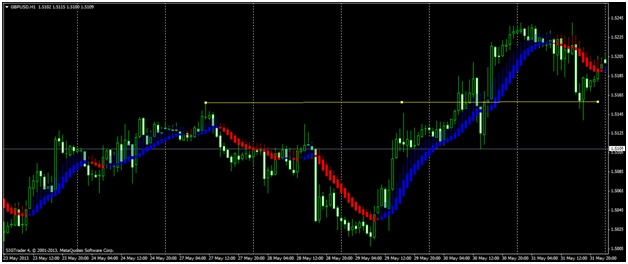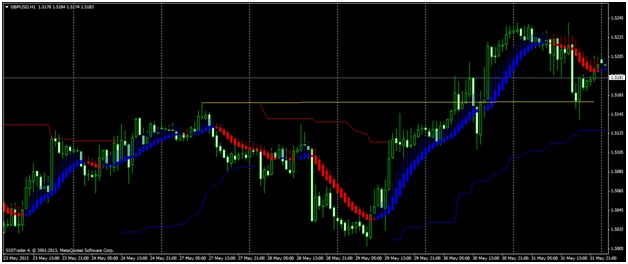Position and Money Management Strategies
Updated: 2017-10-09 09:27:31In the previous article I detailed how sentiment can be analyzed and showed how the change in sentiment led to a 600 pip run in GBPUSD in 1.5 weeks. This article will show how to enter a position and place a stop loss with a pre-defined risk amount, and how use order flow trading analysis to add to the position to maximize returns and minimize risk.
I will start off from my previous article on May 29, 2013 when we think that the sentiment in GBPUSD is turning positive. We see a double bottom from 1.500:
May 29, 2013
With the current price at 1.5060, we enter long … but where do we put a stop loss (SL)? How do we calculate how much to risk?
Looking at the pivot points for this week (calculated from the previous week’s H, L, C), we get:
S2: 1.4873 S1: 1.4999 PP: 1.514 R1: 1.5266 R2: 1.5407
From a previous statistical analysis which I did over several years of data, I know that the probability of the low being less than the S1 for an up week for GBPUSD is about 0.2. The S1 is just below 1.500, which is also the double bottom (and option barrier). Just below this (1.4990) is an excellent place for our initial SL.
Now lets assume we want to risk 2% on the initial trade. If account size is $10,000, we will risk $200. If initial entry is 1.5060, and SL is 1.4990 (70 pips), initial size should be:
($200) * (10000 units / $1 per pip) * (1 / 70 pips) = 28,571 units.
So each pip is worth $2.85. If you have an Oanda account, you can trade exactly 28,571 units of GBPUSD. If not, round down to the nearest number of mini lots (2.8).
After you have your initial position, look at short term (5 or 15 minute) price charts to analyze the price action, and look at other cross pairs for hints. If you see the USD getting weaker against other currency pairs (EUR, CHF, CAD, AUD, JPY, etc) and GBP getting stronger against pairs, GBPUSD will move up. If you see hints of strength in GBPUSD (like USD weakness across the board, or GBPUSD getting bought on dips), its time to add our first position.
Lets say GU has run up 20 pips, and is now at 1.5080. I would put my initial SL at 1.5060 (so risk free initial position), and add more with the same initial SL. The added position would be smaller, since the SL is farther away (now 90 pips).
($200) * (10000 units / $1 per pip) * (1 / 90 pips) = 22,222 units.
So now I have the following long positions in GBPUSD:
| Entry | Units | SL | Risk |
| 1.5060 | 28,571 | 1.5060 | 0 |
| 1.5080 | 22,222 | 1.4990 | 90 pips |
The risk is still the same (2%), but I almost doubled my initial position! As long as the price doesn’t retrace 20 pips from the 2nd entry, we have a good position on the second entry. If it does retrace and SL hits on the first entry, we still have a good position, with slightly smaller initial position.
If I wanted to aggressively add, I could do this one or two more times as price moved up and retraced. For this article, I will assume two initial positions.
May 31, 2013
Its Friday, and GU has moved up and is holding strong near the highs of the week. From statistical analysis I know that if it’s an up week it’s statistically probable for the price to close near the high of the week. Price is above the 1.514 weekly pivot point, and is also above the previous weekly high at 1.5155, and currently stands at about 1.525.
Fundamental data is good and sentiment is positive, and we believe that GU may continue to run for a while. We would like to add more on a retrace, but how much should we add, at what price, and where should the SL be put?
What price to add: When adding a position, we can use the metagaming mindset of trying to think where stops are set. A typical long trader would see the previous highs around 1.5155, so would place SL just below that at 1.515. That is a good place for us to add (as it is also just above the weekly pivot point at 1.514). We can set a limit order to buy at 1.515, with SL and # of units to be calculated as described below. This level is highlighted with the yellow line on the chart below.
Where to set SL: The previous swing low was 1.5107 … a good SL would be just below this at 1.5095. If price retraced to this level the uptrend would seriously be in question (especially with the sentiment analysis which indicates a strong GBP).
How much to add: Once we know what price to add and where to put SL, we can back calculate how much should be added so the overall SL for all positions is 0:
| Entry | Units | SL | PL if SL hit |
| 1.506 | 28,571 | 1.5095 | 99.9985 |
| 1.508 | 22,222 | 1.5095 | 33.333 |
| 1.515 | 24242.09 | 1.5095 | -133.332 |
| TOTAL | 0 |
So we can put a limit order to buy 24,242 units of GU at 1.5150 with SL at 1.5095, and move SL on our other two open positions to 1.5095. If the price spikes down and fills our limit, we have added, but now have 0 total risk in our positions.
We see later in the day that the price spikes down to the weekly pivot, and reverses back up to close near 1.5200 for the week:
Our P&L and average position is now:
| Current PL | |||||
| Entry | Units | SL | Current Price | Pips | $ |
| 1.506 | 28,571 | 1.5095 | 1.525 | 190 | $542.85 |
| 1.508 | 22,222 | 1.5095 | 1.525 | 170 | $377.77 |
| 1.515 | 24242 | 1.5095 | 1.525 | 100 | $242.42 |
| TOTAL | 360 | $920.62 | |||
| Avg position | 1.5095 |
So we have a net unrealized 9.2% gain in just a couple of days, while only risking 2% max loss. Currently if the SL is hit we have 0% loss from all positions combined. Based on the price action and fundamental data (see previous article for details), we believe that GU will continue up more. At this point it is difficult to hold and not exit after such a large gain in a short period of time … but sentiment analysis says GU will head up, so we need to hold and look for opportunities to add. We either hold till our target is high, or trailing stop is hit.
A good long term target is just above 1.5600, since this is the May highs and resistance, so we know there are many stops. We will target this on a “squeeze” of the shorts in GBPUSD (see previous article for COT analysis to determine that there are many shorts in this pair).
A good trailing stop to use is called the “Chandelier exit.” It is computed by taking the highest high of the past 24 bars and subtracting 5 x the average true range of the past 24 bars (on 1 hour charts):
Trailing Long SL = HHV(24) – 5*ATR(24)
A trailing short SL is the same, but adding the 5* ATR. The Chandelier exit is denoted by the solid blue line for longs, and the solid red line for shorts. This is a good point to trail our SL all positions:
June 6, 2013
There were many other short term opportunities to add to current positions (such as dictated by order flow trading on shorter timeframes) … but all subsequent positions should be smaller than the initial positions. If using the trailing SL , one can calculate the subsequent additions (position size, entry, and exit SL for all positions) to maintain a defined risk, 0 risk, or lock in some % of profits with the trailing SL.
Assuming no additional additions (although in reality there are many places to add … especially when analyzing the real time positive GBP sentiment over many days as highlighted in the previous article), we trail our SL at the chandelier exit, but set TP at 1.5620 (just above previous daily highs where there are many long term SL for shorts.
We see price spike up above 1.5600 to run the stops (and ran to 1.568). If we put our take profit orders at 1.560, our net profits would be (assuming no adds):
| Current PL | |||||
| Entry | Units | SL | Current Price | Pips | $ |
| 1.506 | 28,571 | 1.5095 | 1.562 | 560 | $1,599.98 |
| 1.508 | 22,222 | 1.5095 | 1.562 | 540 | $1,199.99 |
| 1.515 | 24242 | 1.5095 | 1.562 | 470 | $1,139.37 |
| TOTAL | 1100 | $2,799.96 | |||
| Avg position | 1.5095 |
So about a 28% gain in 1.5 weeks, risking only 2%! If we let the positions run till the trailing SL hit at 1.554, we would have still netted about a 24% gain.
This article shows how to enter a position with a defined risk, and use sentiment analysis and order flow trading to add to positions and trailing the stop to make the overall positions 0 risk. If we trail the stops or target longer term SL orders, we can use time to our advantage (and the old market wisdom “let your winners run …”) to have larger than normal gains.
Please provide feedback (good or bad) on this article. I would like to improve the analysis if I can and am always open to new ideas!
Regards,
EZcurrency






